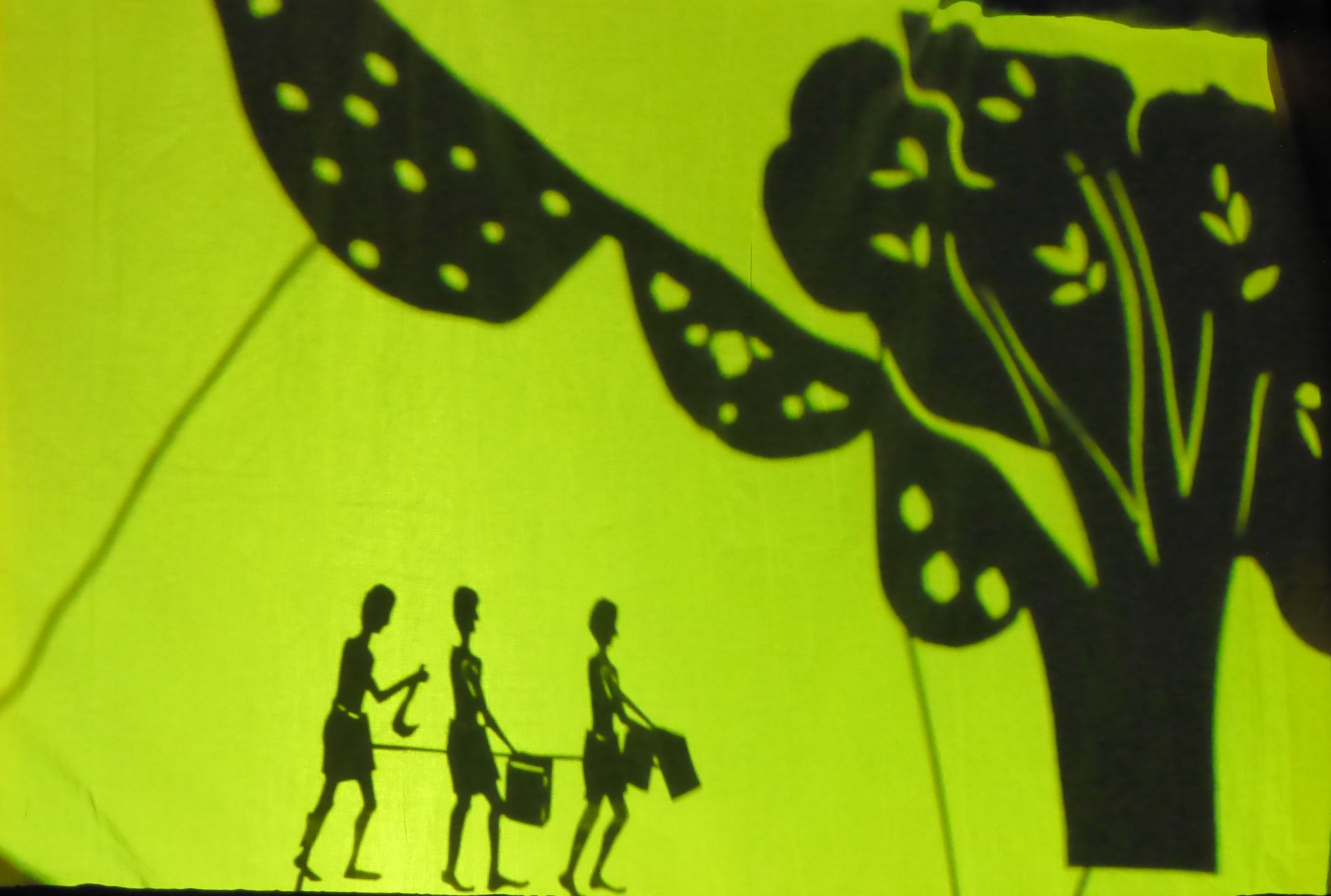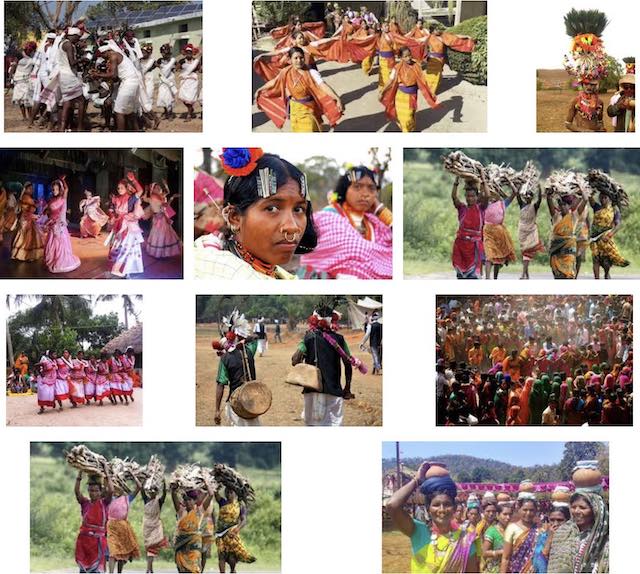
Read the full story >>
Living in the Nilgiris, the Kattunayakans are one of the last few remaining honey gathering communities of the world. Over many generations they have mastered the skills required to tap honey and they take great pride in their knowledge and expertise. For the tribal community, honey gathering is of social, cultural, economic and spiritual relevance. […]
In 2006, the Indian State passed the Forest Rights Act, which for the first time recognised the rights of forest dwelling people on their own land. The Act makes concrete provisions to allow adivasis to enter the forest and continue using forest produce, on which they have depended for generations. However despite this, even today, adivasis are terrorized and harassed by forest officials.
Pictures from a shadow puppet show about the Forest Rights Act, performed in Gudalur by young adivasis
The Tribal communities have been warned of having a legal case slapped against them, apart from being beaten, if they try to venture into the forest in search of honey. Moreover, the authorities have installed wireless surveillance cameras in the forest (originally to track animal movement in the reserve area), which they are using to victimise tribals that wander into the forest in search of bamboo, fire wood, honey and other forest produce.
The conflict is most clearly visible in the language used by officials. Officers and forest guards constantly make references to ‘our beat, our range, and our forest’. As one adivasi poignantly puts it, ‘You ask the Forest Ranger where his house is, he will answer “Palakkad or Madras”, you ask any of us where our home is and we will reply “the forest”’. […]
Pictures from a shadow puppet show about the Forest Rights Act, performed in Gudalur by young adivasis
The Tribal communities have been warned of having a legal case slapped against them, apart from being beaten, if they try to venture into the forest in search of honey. Moreover, the authorities have installed wireless surveillance cameras in the forest (originally to track animal movement in the reserve area), which they are using to victimise tribals that wander into the forest in search of bamboo, fire wood, honey and other forest produce.
The conflict is most clearly visible in the language used by officials. Officers and forest guards constantly make references to ‘our beat, our range, and our forest’. As one adivasi poignantly puts it, ‘You ask the Forest Ranger where his house is, he will answer “Palakkad or Madras”, you ask any of us where our home is and we will reply “the forest”’. […]
The performance in three adivasi languages Paniya, Bettakurumba and Kattunayakan roused discussion about the Forest Rights Act within the community
With access into the forest increasingly becoming a tussle with the authorities, livelihoods and lifestyles are slowly but permanently being altered. For instance, the basket that was once woven in bamboo that was collected from the forest is now being replaced by plastic ones bought from the market. Communities that till recently depended only minimally on money, are now gradually being sucked into the global economy in more ways than one. […]
With their lives in the forest being steadily pulled away from under their feet, communities like the Kattunayakans are losing their sense of culture and meaning. Without the ritual of tapping honey, a rich history of song and dance associated with the practice will have no place in their lives. Perhaps it is okay for some traditions to be left behind, but surely this is a decision that must consciously be taken by the Kattunayakans themselves, rather than by the Forest department official. Will the authorities ever understand Bommi from Chembakolli village when she says “We are nothing without the forest, and the forest is nothing without us”….
Priya, along with three young adivasi girls, works on a cultural revival project for indigenous communities in the Gudalur valley of the Nilgiris, Tamil Nadu.
Source: Home is where the forest is….. | At the Edge of Existence (12 July 2020)
Address : https://cultureandconservation.wordpress.com/2013/08/29/home-is-where-the-forest-is/

https://cdn.downtoearth.org.in/youngenv/GobarTimes/20240515_may_gobar_times.pdf
A fascinating narrative by grandpa Marigan to a curious child, discovering the sacred traditions of the Kattunayakan tribe and how it honours the bees, the bears, and trees for honey by Stan Thekaekara | More by Mari, Stan and Tarsh Thekaekara >>
Up-to-date reports by Indian experts and journalists
Search tips
Combine the name of any particular state, language or region with that of any tribal (Adivasi) community.
Add keywords of special interest (music, poetry, dance just as health, sacred grove and biodiversity); learn about the rights of Scheduled Tribes such as the “Forest Rights Act” (FRA); and the United Nations “Declaration on the Rights of Indigenous Peoples”, “Universal Declaration of Human Rights”, “women’s rights”, or “children’s right to education”.
Ask a question that includes “tribal” or “Adivasi”, for instance: “Adivasi way of life better?” (or “tribal way of life worse?”)
Specify any particular issue or news item (biodiversity, bonded labour and human trafficking, climate change, ecology, economic development, ethnobotany, ethnomedicine, global warming, hunter-gatherers in a particular region or state, prevention of rural poverty, water access).
For official figures include “scheduled tribe ST” along with a union state or region: e.g. “Chhattisgarh ST community”, “Himalayan tribe”, “Scheduled tribe Tamil Nadu census”, “ST Kerala census”, “Particularly Vulnerable Tribal Group Jharkhand”, “PVTG Rajasthan”, “Adivasi ST Kerala”, “Adibasi ST West Bengal” etc.
In case the Google Custom Search window is not displayed here try the following: (1) toggle between “Reader” and regular viewing; (2) in your browser’s Security settings select “Enable JavaScript” | More tips >>
Note: hyperlinks and quotes are meant for fact-checking and information purposes only | Disclaimer >>
List of websites covered by this Google custom search engine
Academia.edu (platform for academics to share research papers) – www.academia.edu
Archive.org – https://archive.org
Centre for Science and Environment – https://www.cseindia.org
Current Conservation – https://www.currentconservation.org
Development and Cooperation (D+C) https://www.dandc.eu
Down To Earth (India) – www.downtoearth.org.in
India Environment Portal – www.indiaenvironmentportal.org.in
Harnessing Nature Magazine – https://harnessingnature.online
Mongabay-India – https://india.mongabay.com
M S Swaminathan Research Foundation – www.mssrf.org
Navdanya (protecting India’s biodiversity based food heritage) – https://navdanya.org
Third World Network (Penang, Malaysia) – https://twn.my
The Shola Trust (nature conservation in the Nilgiri region) – www.thesholatrust.org

Indian online periodicals and platforms | Images view >>
~ ~ ~
Personalize your CustomSearch by combining other search words >>
(e.g. name of a tribal community and region, a craft, or dance and puppetry)
Research the above issues with the help of Shodhganga: A reservoir of theses from universities all over India, made available under Open Access >>
Note: hyperlinks and quotes are meant for fact-checking and information purposes only | Disclaimer >>
See also
ACCORD – Action for Community Organisation, Rehabilitation and Development
Articles by Mari Marcel Thekaekara (writer and Co-Founder of ACCORD-Nilgiris)
Ashwini community health programme
Childhood | Childrens rights: UNICEF India | Safe search
eJournals, eBooks & reports | eLearning
eBook | Background guide for education
Education and literacy | Right to education
Forest Rights Act (FRA) | Legal rights over forest land
Gudalur | Communities: Paniya | Kattunayaka | Mullukurumba | Bettakurumba
Health and nutrition | Recommendations by the Expert Committee
Shola Trust | Nilgiri biosphere
Western Ghats – tribal heritage & ecology
What is the Forest Rights Act about?
Who is a forest dweller under this law, and who gets rights?